Top News
January 14, 2015 Ryukyu Shimpo
Jumbo Tours, a travel agency, has recently resumed charter flights between Thailand and Okinawa (photograph). Charter flights were suspended for about a year due to the unstable political situation in Thailand.
Two-hundred-eighty people from Okinawa departed to Thailand and 292 visitors from Thailand arrived at Naha Air Port for a five-day tour. They enjoyed their trip to Okinawa, visiting Okinawa World (Culture Kingdom Gyokusendo), Okinawa Churaumi Aquarium, and other places. Jumbo Tours is planning to have its next charter flights in May, October and December between Thailand and Okinawa.
(English translation by T&CT, Hitomi Shinzato)
Go to Japanese
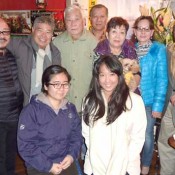
January 19, 2014 Ryukyu Shimpo
On January 17, the Okinawa Association of Bolivia held a New Year’s party with Okinawan Bolivian students who are visiting Okinawa, in Naha. The Bolivian students are third generation Okinawan Bolivian and came to Okinawa with scholarships from the Okinawa Prefectural Government. Aina Ota has been studying Bingata, an Okinawan traditional resist dyeing since last April. Rina Shimabukuro has been hosted in Okinawa under the study program for children of Okinawan immigrants to overseas countries organized by Nanjo City since last December. Event participants celebrated the New Year and interacted with the students.
Ota is scheduled to stay in Okinawa for a year and is studying at a Bingata studio. Shimabukuro will stay for three months and is currently studying Okinawan traditional culture such as Ryubu or Ryukyuan classical dance, and sanshin. They are from Colonia Okinawa where many Okinawan Bolivians live. Ota said, “The spirit of ichariba chode (which in English means “once we meet, we are all brothers and sisters”) in Okinawa is applied to Bolivia as well.” Shimabukuro said, “I feel Okinawa has become urbanized. I would like to study Uchinaguchi (Okinawan language) because my grandparents can speak the language. I am surprised that many young Okinawan people cannot speak the language.”
The association held the event to encourage the students and to promote interaction between its members. They plan to hold the 11th Charity Golf Event, sponsored by Bolivia, on February 18. They will donate the earnings from the event to support students who will come from Bolivia to Okinawa.
(English translation by T&CT)
Go to Japanese

January 13, 2015 Mamoru Yasuda of Ryukyu Shimpo
Sixty years ago, on January 13, 1955, the Asahi Shinbun, one of the five national newspapers in Japan, published a feature article on Okinawa under the U.S military administration. It was a groundbreaking article, which reported on the oppressive situation in Okinawa under the U.S. military administration, for the first time to mainland Japanese. A high school student from Tokyo, who read the article, sent a letter to encourage the people on Ie Island whose land was forcibly acquired by the U.S military. This person is Misako Kikukawa, who was seventeen years old at that time. She started exchanging letters with people in Maja, Ie Village. In August 1955, she donated approximately 800 books and journals she collected to the island. When she visited the island in January 1956, the residents warmly welcomed her.

Misako Kikukawa
Late Shoko Ahagon, who was a leader of land struggles at that time, wrote in his book Beigun to nōmin (The U.S. Military and Farmers), “I felt like she was like a goddess or the sun.” As “the sun of Okinawa” who sheds light of hope on people living with hardships, Kikukawa was featured in local newspapers.
It has been sixty years since she sent her first letter. She now says, “The inequity that burdens and sacrifices Okinawa has not changed for 60 years.” Kikukawa is still distressed by Okinawa’s situation of having U.S military base concentration, and a Japanese government that is forcing the construction of new base.
(English translation by T&CT and Megumi Chibana)
Go to Japanese
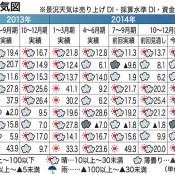
January 17, 2014 Ryukyu Shimpo
On January 16, the Okinawa Development Finance Corporation announced the results of a business conditions survey on the period from October to December 2014 in Okinawa. The diffusion index of business sentiment (DI) in this period increased over the same period the previous year. It demonstrates that Okinawan companies have increased their profits for the seventh period in a row for the first time. The number for “Business Condition Weather” which is a figure based on each DI registered business’s earnings, the break-even level, and cash management during the period was “fine.” The `weather` index number increased to 10.2. The Business Condition Weather has been fine for the seventh period in a row, setting a new record. A representative of the corporation said, “Generally speaking Okinawan companies have been increasing their profits despite labor shortages and high production costs.”
In the breakdown of DI numbers by business type, the number for the manufacturing industry went up by 18.7 percent. The figure for ceramic products was up because a “reactionary decrease phenomenon,” which occurred after the consumption tax hike led to rush demand, disappeared. Due to healthy demand for tourism, the number of restaurant and lodging businesses increased to 37.5, remaining high. The high demand for tourism has had an impact on wholesale and retail businesses. These numbers were all up to 7. Meanwhile, the figures for Information and Telecommunications Industry and hospitality industry have decreased due to a labor shortage. The figures for construction business and transportation business have seen its growth rate declined.
The DI figure for employment conditions, which indicates deficiency or excess of manpower, shows a serious manpower deficiency. The number increased to 31.3, setting a new record.
In particular, the number for the transport industry was up to 51.5. The demand for tourist buses has grown and the construction of a second runway at the Naha Airport has fully started. A lack of drivers in the travel industry and cargo industry has become serious.
Despite labor shortages and high cost of production for raw materials, the DI numbers are expected to continue increasing.
The corporation carried out the survey during the period from the middle of December 2014 to the beginning of January 2015. It targeted companies which have more than 10 million yen in capital, and over 20 employees. Out of 367 companies, the corporation got answers from 345 (94 percent of response rate).
(English translation by T&CT)
Go to Japanese
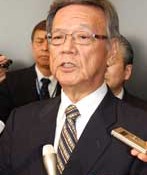
January 15, 2015 Ryukyu Shimpo
On January 14, after cabinet approved the fiscal 2015 promotional budget for Okinawa, Okinawa Governor Takeshi Onaga visited the Prime Minister’s Office and Cabinet Office. At his meeting with Deputy Chief Cabinet Secretary Kazuhiro Sugita, the governor conveyed his opposition to the government’s plan to move U.S. Marine Corps Air Station Futema in Ginowan to Henoko, Nago, and said he sought to relocate it to outside of Okinawa. However, his plan to meet with Prime Minister Shinzo Abe and Chief Cabinet Secreatary Yoshihide Suga, who is responsible for reducing Okinawa’s base burden, was not realized this time.
The governor reported from the meeting that he sought the government official’s understanding of the gubernatorial election outcome, and pledged to block new base construction in Henoko and move the Futenma base to other prefectures or abroad. He told him it was unreasonable for Okinawa to host 74 percent of Japan’s U.S. military exclusive-use facilities when the island is only 0.6 percent of Japan’s land area, now that 69 years have passed since the end of World War II.
The deputy chief cabinet secretary said he would exchange opinions with the governor on how to reduce the base burden.
At his meeting with Yohei Matsumoto, parliamentary vice-minister at the Cabinet Office, the governor showed his appreciation that a certain amount of the Okinawa promotion budget had been ensured.
The governor said, referring to the Okinawa promotion budget reduction, “A required amount was reserved. However, it went up last year.” He showed his willingness to meet with Prime Minister Abe and Chief Cabinet Secreatary Suga, saying it is important to convey what we think to each other.
(English translation by T&CT)
Go to Japanese
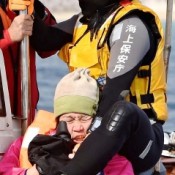
January 21, 2015 Ryukyu Shimpo
The governments of Japan and the United States are moving forward with their plan to relocate U.S. Marine Corps Air Station Futenma to Henoko, Nago. On January 20, workers employed by Okinawa Defense Bureau set up an oil fence from off the coast of Camp Schwab to Oura Bay and dropped anchors on the seabed. According to the defense bureau, the anchors stop the oil fence from being swept away by wave. A line, indicating a temporary restricted area, expands to near the Sedake community, cutting into the deep-blue sea. Screams were heard among members of ‘Canoe Corps’, who are protesting in order to stop the construction work for a new U.S. base. “This is an arrogant way. Their action is like stabbing a sword into Okinawan people’s will,” a member said.
There is a growing backlash against Japan Coast Guard from citizens, because they are removing the protesters with the help of the Okinawa Defense Bureau. A large Okinawa People’s organization, which is against moving the U.S. base within Okinawa and consists of the Okinawa Peace Movement Center, the Helicopter Base Objection Association and other anti-war groups, plans to hold a protest rally in front of the 11th Regional Coast Guard Headquarters in Naha. They will hold a regular protest gathering in front of Nakagusuku Coast Guard Office.
A woman, who was injured by officers during protest action on the sea on January 19, is considering a complaint against them. A man who broke his rib on January 16 will bring an accusation against an officer.
Reporters witnessed a scene in which an officer put his leg on the shoulder of a woman holding a camera on January 20, when the coast guard apprehended protest canoes and ships. The coast guard removed a protest ship on which reporters rode, by dragging it with a rope out of the temporary restricted area. The coast guard interfered with the reporters’ free news coverage for 35 minutes.
(English translation by T&CT)
Go to Japanese
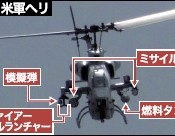
January 17, 2015 Ryukyu Shimpo
At around 17:30 p.m. on January 15, parts of a U.S. Marine AH- attack helicopter belonging to the Futenma base fell during flight in training airspace near Irisuna Island, Tonaki. The parts weighed more than about 200 kilograms, including hellfire missile launcher (about 109 kilograms), missile pot (about 65 kilograms) and empty fuel tank (about 34 kilograms). According to the Okinawa Defense Bureau, any human and material damage has not been confirmed, and explosives were not among the fallen objects, as of January 16. The Okinawa Prefectural Government Office and Okinawa Defense Bureau asked the U.S. side to investigate the cause of the accident and to prevent recurrence.
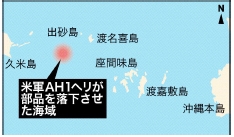
U.S. Marine Corps notified the defense bureau in the afternoon on January 16, and the prefecture, Ginowan City and Tonoki Village office received the information from the defense bureau at 2 p.m. According to the U.S. Marine Corps, the parts fell into the sea from the helicopter when it was flying in training airspace after departing from the Futenma base on January 15.
In March last year, there was an incident where the skid of an AH-1 helicopter belonging to the Futenma base collapsed in its landing on the deck of U.S.S. Denver off the coast of Okinawa’s main island. In addition to this accident, a metal ring bolt 7.6 cm in diameter and 5.1 cm long fell from an AH-1 helicopter during training in September. Accidents involving the helicopters have taken place one after another.
Susumu Matayoshi, the head of the Executive Office of the Governor, criticized the U.S. military, saying, “Numerous accidents involving U.S. military have taken place so far. This is more serious because parts of its anti-tank guided and anti-ground missile have fallen from the helicopter. We cannot help but raise doubts over whether or not the U.S. military has carried out measures to prevent the accidents. This can lead to serious accidents.”
The Okinawa Prefectural Government called for a full investigation into the cause of the accident, a public announcement of the results of the investigation and specific measures to prevent recurrence by the U.S. military. The defense bureau made a proposal for safety management to prevent accidents and an investigation into the accident to the U.S. military.
(English translation by T&CT)
Go to Japanese
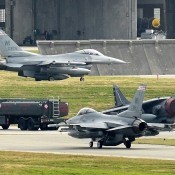
January 15, 2014 Ryukyu Shimpo
Four F-16 Fighting Falcon belonging to the Wisconsin Air National Guard base flew in to Kadena Air Base at 3:14 p.m. on January 15. The air national guard base announced a plan to temporarily station 12 Fighting Falcon at Kadena Air Base. Deployment of all the aircraft to the air base was complete within a day.
The U.S military will station Fighting Falcon at the air base for several months and carry out training based at Kadena.
This is a part of a strategy the United States Pacific Command says it has carried out to strengthen the mission execution ability of each of its units in the Asia-Pacific region. A U.S Department of Defense official stated that the U.S military stationed the aircraft to apply the brakes to North Korea.
F-16 Fighting Falcon and troops will be under the command of the U.S air force’s 18th Wing at Kadena Air Base. The military has temporarily stationed the aircraft to strengthen collaboration between the 18th Wing and the Japan Self Defense Forces in operating aircraft and preventing disasters.
(English translation by T&CT)
Go to Japanese
January 15, 2014 Ryukyu Shimpo
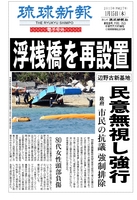 The governments of Japan and the United States plan to construct a replacement base for U.S Marine Corps Air Station Futenma in Henoko, Nago. The Okinawa Defense Bureau resumed setting up a float bridge when they placed an oil fence off the coast of Henoko at 11 a.m. on January 15. Concerned the construction work could influence Lower House election at the end of last year, the bureau had halted the offshore operation and removed the float bridge from the sea. However, they have now resumed the operation. At several spots, the bureau used a crane truck to lower an oil fence on the beach. Construction workers then used ships to stretch the oil fence over the sea off Henoko. The setting up of the bridge was expected to take a full day.
The governments of Japan and the United States plan to construct a replacement base for U.S Marine Corps Air Station Futenma in Henoko, Nago. The Okinawa Defense Bureau resumed setting up a float bridge when they placed an oil fence off the coast of Henoko at 11 a.m. on January 15. Concerned the construction work could influence Lower House election at the end of last year, the bureau had halted the offshore operation and removed the float bridge from the sea. However, they have now resumed the operation. At several spots, the bureau used a crane truck to lower an oil fence on the beach. Construction workers then used ships to stretch the oil fence over the sea off Henoko. The setting up of the bridge was expected to take a full day.
In the Okinawa gubernatorial election and in the Lower House election, all the candidates opposing construction of the new base defeated candidates backed by the ruling Liberal Democratic Party. Okinawan people have continued to oppose the base construction. However, the Japanese government has resumed the offshore operation while forcibly removing citizens protesting against the plan. The central government is not even trying to hide its heavy-handed approach of forcing through the Henoko relocation.
Four ships and canoes carrying protesters gathered to try to prevent construction in the marine area where the Okinawa Defense Bureau resumed the construction. Alleging the protesters entered an off-limits area, Japan Coast Guard officers, who were on inflatable boats, captured about 20 of them at 10:30 a.m. The scene has gotten tense.
In front of the gate of Camp Schwab, over 100 citizens held protest rallies and staged a sit-in protest. There have been standoffs continuing between citizens and Okinawan Prefectural Police. A woman in her 80s fell to the ground and hit her head hard. Around 8:10 a.m., she was carried by ambulance to the hospital.
(English translation by T&CT)
Go to Japanese
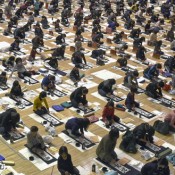
January 11, 2015 Ryukyu Shimpo
The 25th Kakizome Festival was held at the Okinawa Prefectural Budokan in Naha City on January 10. The event involves around 1,000 people writing kanji and prizes are awarded.
About 1,050 people ranging from three to 68 year-old took part in this year`s event. The participants worked diligently on writing their kakizome or first calligraphy. Ginoza Junior High School student Kaito Yamada received the Prime Minister’s Award, which is the top award in the event.
In the closing ceremony, calligrapher Nanryu Chihara wrote the Chinese character “Sho (flying),” which includes this year’s Chinese zodiac sign of sheep in its Bushu or Chinese radical.
(English translation by T&CT)
Go to Japanese
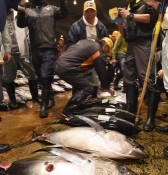
January 5, 2015 Ryukyu Shimpo
In the early morning of January 5, fishery and government officials prayed for a safe, bumper and prosperous year for business at the first auction of 2015 at Tomari Fish Market in Naha. The market resounded with the excited voices of middlemen. Buyers mainly bid on fresh tuna and marlins.
About 44 tons, almost all tuna (40 tons), was landed on the day. The highest price was paid for bigeye tuna, with 3,500 yen per one kilogram recorded. Three thousand yen per one kilogram was bid on high-class fish red-spotted rockcod.
(English translation by T&CT, Hitomi Shinzato)
Go to Japanese












 Webcam(Kokusai Street)
Webcam(Kokusai Street)


